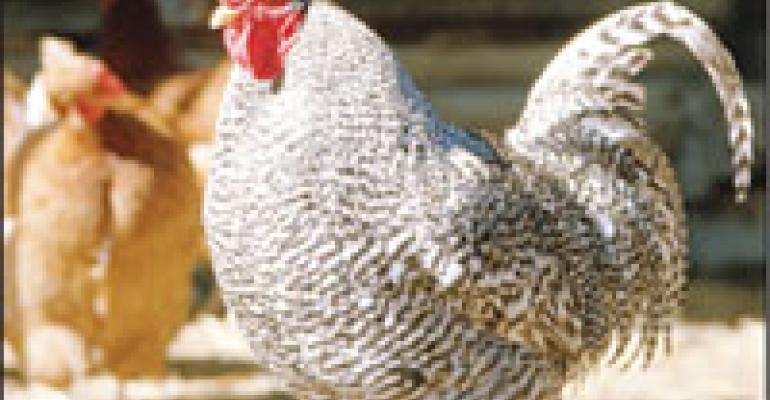The U.S. Department of Agriculture’s July Supply & Demand report further diminished fears of Midwest flood damage to this year’s corn crop. While corn yields have been lowered from 148.9 bushels per acre to 148.4, private analysts had anticipated much lower yields in the 144 to 147 bushels-per-acre range. The new 2008-09 corn production forecast for 11.715 billion bushels is an almost negligible reduction from last month’s preflood forecast of 11.735 billion. That’s still down from 13.1 billion bushels last year, but it is a best-case scenario given the flood-scare, doomsday reports of just a few weeks ago. Corn futures plummeted from record highs of $7.54 per bushel on June 27, to $6.75 on July 10.
Beef—June’s USDA cattle report showed a continuation of the trend toward lower placements that began two months ago. New feedlot placements in May were down 12 percent, following a 2-percent drop in April and an 11-percent year-over-year decline in March. There were 10.8 million head of cattle on feed as of June 1, down 4.1 percent from a year ago. Smaller March, April and May placements will result in tighter feed cattle supplies and less beef production as we move from summer into the fall.
The stage is set for smaller supplies by late summer and for upward pressure on beef prices from fall of 2008 through 2009. After gaining about 3 percent in the first half of 2008, beef output is projected to decline by about 1 percent in the second half. Output in the fourth quarter could be as much as 4 percent below a year ago. The USDA is slowing choice steer prices for 2009 at 93 cents per pound, up roughly 2 percent from an average of 91 cents in 2008.
Coffee—With the Brazilian winter upon us, freeze speculators pushed prices higher, from $1.28 to $1.50 in June, but that’s still well below highs of $1.65 in February. Weather-related harvest delays in Brazil slowed new-crop availability at a time when old-crop supplies are just about exhausted. On the plus side, the USDA’s new estimate of Brazil’s 2008-09 harvest came in on the high side at 51.1 million bags. Coffee futures were in the $1.40 range in mid-July. If the Brazilian winter passes without any crop damage, prices will likely be lower by mid-August.
Dairy—In June, the USDA lowered 2008 milk output by roughly 10 percent to 188.3 billion pounds. That’s still 2.1 percent above a year ago. Production in 2008 will be very front-loaded. Following a 2.8-percent increase in the first half, a flat-to-negative second-half output threatens to pull down the annual average increase to the 1-percent range.
Milk output peaked seasonally in May and helped cheese inventories build in spite of strong export sales. As a result, cheese markets finally broke, from a high of $2.28 in May to the low $1.90s in mid-July. However, continued increases in exports and the approaching fall holidays will likely push cheese markets back above $2 by late summer. Block cheese is now forecast to average $1.96 in 2008, up 12.8 percent from nearly $1.74 in 2007.
After bottoming at $1.18 in February, butter prices have moved steadily higher to $1.55 by mid-July. Seasonally lower fat content in milk and competition from ice cream makers should keep cream supplies tight through summer. April butter exports were reported to be six times 2007 levels and accounted for roughly 10 percent of all U.S. output, further compounding the supply situation.
Oil—The global vegetable oil market will continue to tighten as demand continues to outpace supply. In 2008-09, China’s consumption of soybean oil is expected to grow 5 percent, while palm oil imports are forecast to be 7 percent higher. U.S. soybean output is projected to be up 16 percent from 2007. But 2008-09 soybean crush is forecast to increase by less than 1 percent, reflecting a small increase in domestic soybean meal use and a decline in soybean meal exports. A rise in crude-oil prices and a tighter, flood-reduced outlook for crop supplies have spurred another rally in soybean oil prices. Soy-oil futures closed above 64 cents July 10 and are up a dime since early May. Soybean oil prices for 2008-09 are currently projected to average 54 cents, up about a half-cent from 2007-08.
Pork—The June 27 USDA Hogs & Pigs Report showed 67.7 million head in inventory, up 5.8 percent from a year ago and about 1.5 percent more than expected. The biggest increases were in the heaviest weight categories, which just about guarantees a flood of pork coming to market in the second half of 2008. Next year things will slow down a bit. Second-half 2008 farrowing intentions average 3 percent below a year ago. The USDA’s 2009 pork production forecast is currently 22.7 billion pounds, 2.9 percent below 2008. For 2008 and 2009, hog prices are expected to average 47 cents and 49 cents per pound, respectively.
Poultry—Similar to beef supplies, a 4.4-percent year-over-year first-half supply increase should give way to a 0.2-percent second-half deficit. 2009 production will recover just modestly to 0.8 percent above 2008 levels. Even given lower production, exports are not expected to back off. Exports in 2008 are forecast at a record 6 billion pounds, about 16.3 percent of total U.S. output. 2009 broiler exports are forecast to be 2 percent higher. Broiler prices are now projected to increase from an average of more than 76 cents per pound in 2007 to nearly 81 cents in 2008 and 83 cents in 2009.
In turkey, 16-pound-to-22-pound frozen toms at 92 cents per pound will inch higher into Thanksgiving, probably hitting $1 in October. The USDA’s 2008 price projection is nearly 90 cents, up 9 percent from just over 82 cents in 2007. Prices in 2009 will average about 2 percent lower as rising output and a weak domestic economy put downward pressure on whole-bird prices.




